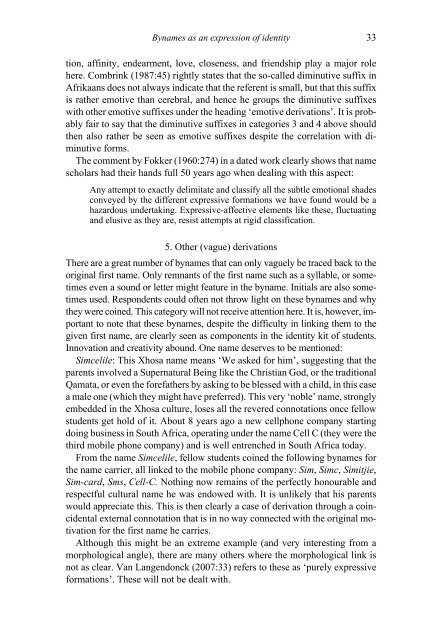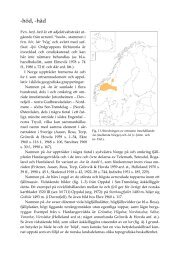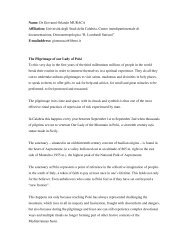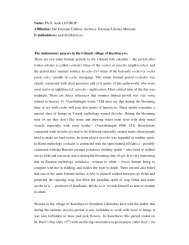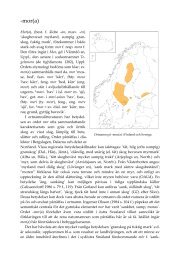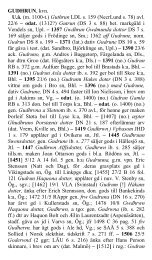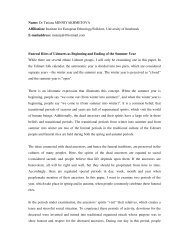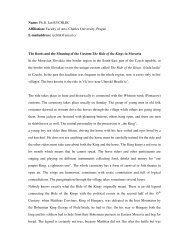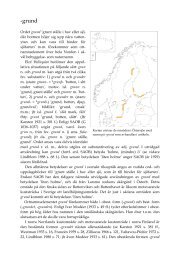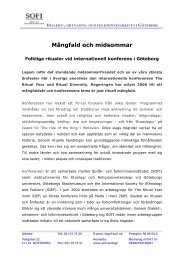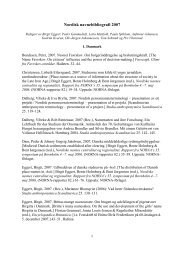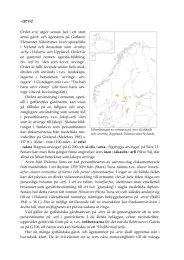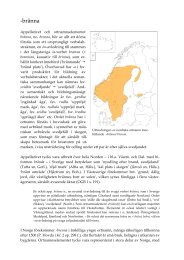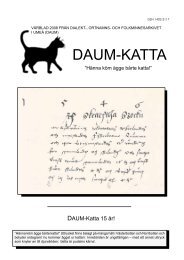NORNA-RAPPORTER 88 Binamn. Uppkomst, bildning, terminologi ...
NORNA-RAPPORTER 88 Binamn. Uppkomst, bildning, terminologi ...
NORNA-RAPPORTER 88 Binamn. Uppkomst, bildning, terminologi ...
You also want an ePaper? Increase the reach of your titles
YUMPU automatically turns print PDFs into web optimized ePapers that Google loves.
Bynames as an expression of identity 33<br />
tion, affinity, endearment, love, closeness, and friendship play a major role<br />
here. Combrink (1987:45) rightly states that the so-called diminutive suffix in<br />
Afrikaans does not always indicate that the referent is small, but that this suffix<br />
is rather emotive than cerebral, and hence he groups the diminutive suffixes<br />
with other emotive suffixes under the heading ‘emotive derivations’. It is probably<br />
fair to say that the diminutive suffixes in categories 3 and 4 above should<br />
then also rather be seen as emotive suffixes despite the correlation with diminutive<br />
forms.<br />
The comment by Fokker (1960:274) in a dated work clearly shows that name<br />
scholars had their hands full 50 years ago when dealing with this aspect:<br />
Any attempt to exactly delimitate and classify all the subtle emotional shades<br />
conveyed by the different expressive formations we have found would be a<br />
hazardous undertaking. Expressive-affective elements like these, fluctuating<br />
and elusive as they are, resist attempts at rigid classification.<br />
5. Other (vague) derivations<br />
There are a great number of bynames that can only vaguely be traced back to the<br />
original first name. Only remnants of the first name such as a syllable, or sometimes<br />
even a sound or letter might feature in the byname. Initials are also sometimes<br />
used. Respondents could often not throw light on these bynames and why<br />
they were coined. This category will not receive attention here. It is, however, important<br />
to note that these bynames, despite the difficulty in linking them to the<br />
given first name, are clearly seen as components in the identity kit of students.<br />
Innovation and creativity abound. One name deserves to be mentioned:<br />
Simcelile: This Xhosa name means ‘We asked for him’, suggesting that the<br />
parents involved a Supernatural Being like the Christian God, or the traditional<br />
Qamata, or even the forefathers by asking to be blessed with a child, in this case<br />
a male one (which they might have preferred). This very ‘noble’ name, strongly<br />
embedded in the Xhosa culture, loses all the revered connotations once fellow<br />
students get hold of it. About 8 years ago a new cellphone company starting<br />
doing business in South Africa, operating under the name Cell C (they were the<br />
third mobile phone company) and is well entrenched in South Africa today.<br />
From the name Simcelile, fellow students coined the following bynames for<br />
the name carrier, all linked to the mobile phone company: Sim, Simc, Simitjie,<br />
Sim-card, Sms, Cell-C. Nothing now remains of the perfectly honourable and<br />
respectful cultural name he was endowed with. It is unlikely that his parents<br />
would appreciate this. This is then clearly a case of derivation through a coincidental<br />
external connotation that is in no way connected with the original motivation<br />
for the first name he carries.<br />
Although this might be an extreme example (and very interesting from a<br />
morphological angle), there are many others where the morphological link is<br />
not as clear. Van Langendonck (2007:33) refers to these as ‘purely expressive<br />
formations’. These will not be dealt with.


